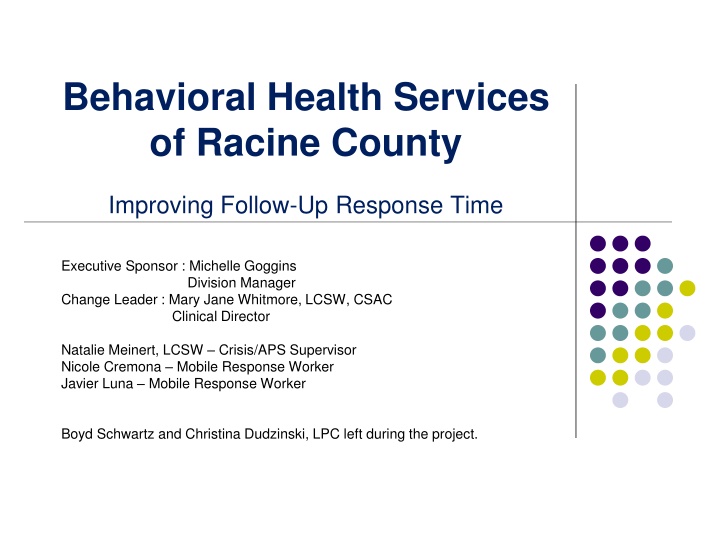
Improving Follow-Up Response Time in Racine County Behavioral Health Services
In this project, Racine County Behavioral Health Services aims to decrease readmission rates by improving follow-up response times. Key strategies include defining meaningful contact, enhancing communication, and sustaining progress through continuous cycles. The impact includes cost savings, effective resource utilization, and manageable caseloads. Lessons learned emphasize clear communication and adaptability to external influences.
Download Presentation

Please find below an Image/Link to download the presentation.
The content on the website is provided AS IS for your information and personal use only. It may not be sold, licensed, or shared on other websites without obtaining consent from the author. If you encounter any issues during the download, it is possible that the publisher has removed the file from their server.
You are allowed to download the files provided on this website for personal or commercial use, subject to the condition that they are used lawfully. All files are the property of their respective owners.
The content on the website is provided AS IS for your information and personal use only. It may not be sold, licensed, or shared on other websites without obtaining consent from the author.
E N D
Presentation Transcript
Behavioral Health Services of Racine County Improving Follow-Up Response Time Executive Sponsor : Michelle Goggins Division Manager Change Leader : Mary Jane Whitmore, LCSW, CSAC Clinical Director Natalie Meinert, LCSW Crisis/APS Supervisor Nicole Cremona Mobile Response Worker Javier Luna Mobile Response Worker Boyd Schwartz and Christina Dudzinski, LPC left during the project.
Aim Big Aim: Decrease Racine County s readmission rate. Small Aim: +/- 90% for contacts within 24 48 hrs Focused on 2ndcontacts during 48 hrs 30 day window. Improve the timeliness and quality of follow up contact by the Mobile Response Unit. Will improve contact with consumers after the initial 24-48 hour window by 10%. Base Line average 75% Goal 85%
Change Define what constitutes a meaningful contact. Meaningful Contact actual phone conversation, completed home visit or meeting with the consumer, or admission into the SAIL program. Some overlap between cycle 1 and 2 because meaningful contact needed further explanation. Confusing for some workers. Add additional white board for Mobile Responders to clearly identify consumers in need of 2ndcontact and date of last contact. Adaption - Have the board closer to the Mobile Response work area so that it remains in their line of sight and more difficult to overlook.
Results Improved 2ndcontacts to 82.5% Unable to determine September results due to a change in our reporting system. 100 Baseline Ave 80 60 40 % of successful 2nd contacts 20 0 May June July Aug (after 1st change)
Next Steps Sustaining the first cycle. The adopted definition was told to staff; working on formalizing. Incorporating the standard while training new staff. Adapting the white board from the 2ndcycle. Future cycles being considered: Improved communication with shareholders. Assigning consumers to each worker to follow up with. Re-organizing staffing patterns.
IMPACT With cost savings due to hospitalizations, it will ensure that Racine County s limited resources are effectively utilized which could mean hiring additional workers or upgrading technology/facilities. It will also has a trickle down effect with other units and with consumers. Case load size in Ongoing Crisis, CCS, and CSP are manageable and effective. SAIL consumers will be appropriate for that level of care. Lessons Learned Be sure that changes are well communicated to all staff and shareholders. Keep ideas for change concise. Don t over think the change project or rapid cycles. Some community influences are out of your control, i.e. change in admission policies at local hospitals, floods, etc.
